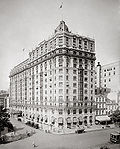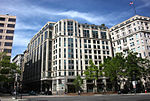The Woman Suffrage Procession on 3 March 1913 was the first suffragist parade in Washington, D.C. It was also the first large, organized march on Washington for political purposes. The procession was organized by the suffragists Alice Paul and Lucy Burns for the National American Woman Suffrage Association (NAWSA). Planning for the event began in Washington in December 1912. The parade's purpose, stated in its official program, was to "march in a spirit of protest against the present political organization of society, from which women are excluded."
Participation numbers vary between 5,000 and 10,000 marchers. Suffragists and supporters marched down Pennsylvania Avenue on Monday, March 3, 1913, the day before President Woodrow Wilson's inauguration. Paul had selected the venue and date to maximize publicity, but met resistance from the D.C. police department. The demonstration consisted of a procession with floats, bands, and various groups representing women at home, in school, and in the workplace. At the Treasury Building, a pageant of allegorical tableaux was acted out during the parade. The final act was a rally at the Memorial Continental Hall with prominent speakers, including Anna Howard Shaw and Helen Keller.
Prior to the event, the issue of black participation in the march threatened to cause a rift with delegations from Southern states. Some black people did march with state delegations. A group from Howard University participated in the parade. It is often said that black women were segregated at the back of the parade, however, contemporaneous sources confirm they marched with their respective state delegations or professional groups.
During the procession, district police failed to keep the enormous crowd off the street, impeding the marchers' progress. Many participants were subjected to heckling from spectators, though there were also many supporters present. The marchers were finally assisted by citizens' groups and eventually the cavalry. The police were subjected to a congressional inquiry due to security failures. The event premiered Paul's campaign to refocus the suffrage movement on obtaining a national constitutional amendment for woman's suffrage. This was intended to put pressure on President Wilson to support an amendment, but he resisted their demands for years afterward.
The procession was featured in the film Iron Jawed Angels in 2004. A new U.S. ten-dollar bill with parade imagery is planned for circulation in 2026.










